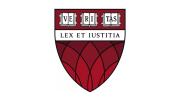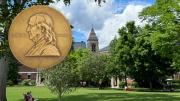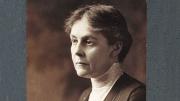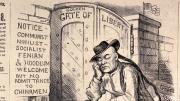More than five years after the Harvard Corporation acceded to Harvard Law School’s decision to abandon its shield, associated with slavery, it has approved the school’s replacement. The new shield was developed by the HLS Shield Working Group, first convened in 2020, and design firms PopKitchen and Studio Rainwater.
“I am grateful to our community for taking part in this important process and for the values and aspirations they ascribe to HLS,” wrote Dean John F. Manning in an email. “Members of our community shared with the Working Group that, because of HLS’s wide-ranging scope, depth, and diversity, the Law School does not represent any one school of thought, but is a place where people engage productively around many approaches, methodologies, and points of view in the pursuit of truth and knowledge.”
Only Harvard’s traditional motto veritas splayed over three open books seems to carry over from the former design. Added beneath the motto is an additional Latin phrase: Lex et Iustitia (“law and justice”). The remainder of the shield features eight overlapping, curved lines inspired by details found in the arches and windows of HLS’s Austin and Hauser halls.
“The traditional elements of the shield speak to the school’s history and grounding, while the more modern forms convey its ongoing evolution and aspirational nature,” according to an explanation on the HLS website. “When combined with color, the multiple radiating lines express an internal energy, light, and strength, conveying a community with many facets and nuances, none of which alone defines it.” The description, and design, follow the three themes emphasized by the Working Group chaired by Loeb University Professor Annette Gordon-Reed: a diverse and pluralistic community, leadership that changes the world for the better, and the fundamental pursuit of law and justice.
The new shield replaces the original design, first implemented in 1937, which displayed the crest of the slaveholding Royall family, whose fortune endowed the school’s first faculty chair. It was the 2015 book On the Battlefield of Merit: Harvard Law School, the First Century, coauthored by former visiting professor Daniel Coquillette, J.D. ’71 and Bruce A. Kimball, M.Div. ’78, Ed.D. ’81, that brought this history to light. Although a 2016 report acknowledged there was no evidence that the 1936 Harvard Corporation knew that Isaac Royall Jr. owned slaves, a committee of HLS professors, students, and alumni recommended that the school abandon the former crest. “We cannot unsee what we now know, nor should we,” the report argued. “The Law School would not today honor Isaac Royall and his bequest by taking his crest as its official symbol.” In 2017, the HLS memorialized the names of 60 slaves held by the Royall Family in a plaque placed at the center of the school’s campus. “Our school was founded with wealth generated through the profoundly immoral institution of slavery,” Manning said at the monument’s unveiling. “We should not hide that fact nor hide from it.…To be true to our complicated history we must also shine a light on what we are not proud of.”








